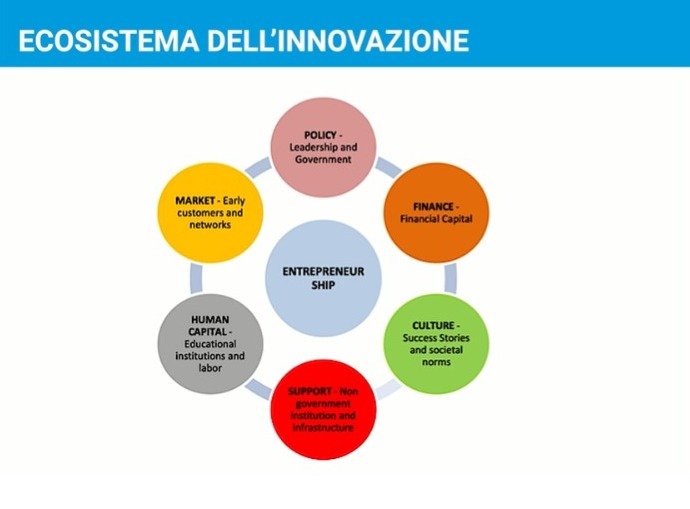Which actors support an innovation phase for your company? First of all, we need to define an innovation ecosystem even more precisely, referring to the main actors that make it up. The innovation ecosystem is a system of policies e regulations enablers, accessibility to financial capital, human capital informed, supportive markets, infrastructure, one culture innovation and entrepreneurship and resources of networkwhich all together support productive relationships between different actors and other parts of the ecosystem.

Ecosystem actors and stages in the life cycle of a company
Every innovative enterprise follows a life cycle cadenced by a succession of phases that take it from the discovery, to the validation of the innovative idea, to the achievement of efficiency to the growth and scalability phase of the business. During the life cycle, businesses need different resources to grow.
An ecosystem capable of supporting the growth of innovative companies must therefore be able to provide the adequate resources at the appropriate time.
Initial stages
The initial phase of the life cycle of an innovative enterprise (discovery and conception) sees the definition and analysis of the market problem to be addressed and potential solutions are generated by scanning existing alternative solutions and new innovative ideas. A fundamental role is played by the research institutions through their contribution in the creation and dissemination of knowledge and the generation of entrepreneurial spirit among entrepreneurial students that will contribute to the future human capital of innovators and inventors. From a financial point of view, given the embryonic and uncertain nature of the innovative idea, traditional investors are almost absent. Consequently, the circle of supportive friends and family (Friends & Family) will often be crucial in helping entrepreneurs take their idea forward.
The next phase of research and developmentinnovation in its more technical aspects. is generally supported by incubators and accelerators for the business part and by development agencies for the financial part.
Incubators and accelerators play an important role in the innovation ecosystem in providing a favourable environment for start-ups and early-stage companies. This typically includes a physical space where innovators can gather and share ideas while taking advantage of shared infrastructure and technology equipment. They also often provide innovators with access to a network of business and technical advisors/mentors who can provide guidance and assistance in the development of the product, finance, business planning, marketing, legal advice, production, and all aspects of business development.
Most of the development agencies tends to focus on supporting early-stage innovators, helping them with relatively small amounts of funding seedoften as competitive challenge prizes ('Challenge Prizes'). In recent years, however, such actors are expanding their financial instruments and taking on roles more similar to those of traditional investors (Venture Capitalists) albeit with smaller amounts of capital.
Central phase
In the phase of proof of concept the intellectual concept behind the innovation is field-tested to obtain an initial assessment of its potential for the real market.
I Business angels play an important role in helping small companies overcome common financing gaps between the research and development phase and the transition phase towards business scalability. They are often less risk-averse than venture capitalists and often directly promote innovations by taking a position on the start-up's board of directors, assisting its management with their knowledge and experience, and also expanding the range of contacts and networks the company needs to secure additional backers and further financing. The role of development agencies described earlier remains relevant even at this stage.
Towards scalability
In the next phase of transition to scalability of the business, innovations that have shown success on a small scale develop further and begin to attract partners to help fill existing gaps for large-scale growth. This is where the role of venture capital becomes predominant.
A venture capitalist is an investor who provides capital to small, innovative and high-potential companies that wish to expand but do not have access to the stock markets. Venture capitalists are willing to invest in such companies because they can earn a huge return on their investment if these companies succeed. Although venture capitalists may suffer severe losses when their choices fail, these investors are structured in such a way that they can afford to take the risks associated with financing young, unproven companies that appear to have a great idea and a good management team. Their investment is usually much larger than an Angel Investor.
When the process of replicating or adapting an innovation for an ever-widening geographic coverage capable of creating global transformational impact begins, one is in the real Scaling. Le private equity firms play the main role here. In contrast to venture capitalists, private equity firms are typically interested in more mature companies with an established business, although they may also sometimes buy companies that may deteriorate or fail to realise the sought-after profits due to internal inefficiencies through leaner transactions in order to increase revenues.
Transversal figures
In addition to these actors, they play an important role along all stages of the cycle of transversal figures.
The role of facilitators and the intermediaries of the marketplace is to connect organisations within an innovation ecosystem and facilitate the transfer of ideas, technology and other resources to help commercialise them at scale. Ideally, they are small and agile entities (sometimes just individuals) that are perceived as neutral or impartial within the ecosystem, which allows them to provide important 'bridging' functions between actors that might otherwise struggle to collaborate, understand or trust each other. As such, they are often the 'glue' that helps hold an ecosystem together and can take a broad perspective between all the various actors involved to help shape and improve the way they interact for different purposes.
Various professionals with their range of technical skills, passion, determination and risk-taking behaviour are critical to driving innovation forward, even in the face of the inevitable and often significant challenges and obstacles that will arise along the way. If there is not enough human capital within an ecosystem, the competition over talent that exists intensifies and undermines true collaboration and trust between the different actors.
I governments play many critical roles in fostering innovation, mainly in terms of creating a supportive policy and regulatory environment in which start-ups are encouraged and able to thrive through a variety of tax incentives or partnerships that enable the growth of scientific research, the availability of capital through business angels, venture capitalists and private equity. They are also essential to ensure that innovators have access to the technological infrastructure they need to advance their products and networks. Governments can even play an 'entrepreneurial' role by imagining and funding the creation of entire new fields ripe for innovation and then acting as partners to help bring successful innovations to sustainable scale and impact.
The private sector plays a crucial role in innovation ecosystems. Business-led initiatives such as research and development partnerships, knowledge-sharing platforms, technology and skills transfer and infrastructure investments have the potential to catalyse, develop and scale innovation, while providing fertile ground for future innovations to emerge. Although driven primarily by profit considerations, private companies increasingly recognise the importance of working in partnership with governments, research institutes, development agencies and civil society actors to collaboratively address large-scale social/economic issues that hinder the development of new markets and the efficiency of their broader business environments.
The Triple Helix
The model of the Triple propellerwhich can be scientifically traced back to Etzkovitz-Leydersdorff, focuses on the system of relationships that develops between universities, private sector and government being able to create an environment conducive to transfer of knowledge and the consequent development of innovation, through the overlapping of the institutional spheres underlying the model.
This model plays a key role especially when it comes to sustainable innovation. New technological trends are significantly accelerating changes in the economy and society at a pace that has never been experienced before.
Feeding a growing population in a healthy and sustainable way; providing the energy needed to sustain the daily lives of billions of people; generating the resources needed to ensure equitable growth for all, are some of the major challenges that need to be addressed globally. New models of cooperation are therefore needed where government, industry and academia come together and join forces to seize opportunities and reduce obstacles towards a sustainable development of our society.






